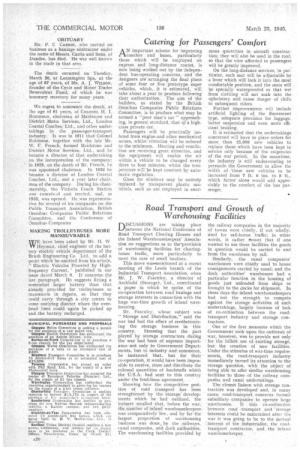Catering for Passengers' Comfort A N important scheme for improving coaches
Page 22

If you've noticed an error in this article please click here to report it so we can fix it.
and buses, particularly those which will be employed on express and long-distance routes, is now being worked out by the independent bus-operating concerns, and the designers are arranging the final plans of some four or five prototype super _vehicles, which,, it is estimated, will take about a year to produce following their authorization. The aim of the builders, as stated by the British . Omnibus Companies Public Relations Committee, is to produce what may be termed a "poor man's car " approaching, in general standard, that of a highclass private car.
Passengers will be practically isolated from engine and other mechanical noises, whilst vibration will be reduced to the minimum. Heating and-ventilation are receiving great attention, and the equipment will enable the air within a vehicle to be changed every three to four minutes, whilst the temperature will be kept constant by automatic regulation.
Glass for windows may be entirely replaced by transparent plastic materials, such as are employed in enor mous quantities in aircraft construction; they will also be used in the roof; so that the view afforded to passengers will be greatly improved.
On the long-distance services, in particular, each seat will be adjustable by a lever which will lock it into the most comfortable position, and the seats will tle specially waterproofed so that wet from clothing will not soak into the upholstery and cause danger of chills to subsequent riders.
Further improvements will include artificial lighting of the fluorescent type, adequate provision for luggage, better suspension and even more efficient braking.
It is estimated that the undertakings concerned will have to place orders for more than 25,000 new vehicles to replace those which have been kept in service only because of the exigencies of the war period. In the meantime, the industry is still endeavouring to persuade the Government to allow the width of 'these new vehicles to be increased from 7 ft. 6 ins. to 8 ft., which factor alone would add appreciably to the comfort of the bus passenger.




















































